CHAPTER 5
5-HT modulators and other antidiarrheal agents and cathartics
Introduction
Serotonin (5-hydroxytryptamine or 5-HT) is an important neurotransmitter involved in multiple functions both in the central nervous system and the periphery. Most of the body 5-HT is synthesized in the gastrointestinal (GI) tract, where 5-HT modulates various aspects of intestinal physiology. The wide-ranging effects of serotonin can be explained by the presence of multiple subtypes of 5-HT receptors located on various types of cells (smooth muscle, enteric neurons, enterocytes, and immune cells). Agonist or antagonists of 5-HT receptors are used for the treatment of a range GI disorders (e.g., irritable bowel syndrome, chronic diarrhea, constipation and functional dyspepsia). In addition to 5-HT serotonin agents, there are several other classes of medications used for the treatment of chronic diarrhea and constipation. This chapter will provide information on the clinical use of 5-HT modulators in GI disorders and other anti diarrheal agents and cathartics.
5-HT modulators used in the management of GI disorders
Biology and pharmacology
Serotonin plays a crucial role in the regulation of multiple intestinal functions, including motility, secretion, visceral sensitivity, immune/inflammatory responses, and regulation of the autonomic nervous system. The majority (95%) of the body’s serotonin is found in the intestine, with the remainder (5%) residing in CNS neurons and platelets. Within the bowel, serotonin is synthesized from its precursor, amino acid, L–tryptophan, in the enterochromaffin (EC) cell and by serotonergic neurons of the myenteric plexus. Serotonin exerts its effects via neurocrine, paracrine, and endocrine pathways. It acts as a paracrine messenger of the EC cells, which are sensory transducers. Serotonin activates intrinsic and extrinsic primary afferent neurons to initiate peristaltic and secretory reflexes and to transmit information to the central nervous system, respectively. 5-HT inactivation is accomplished by a serotonin reuptake transporter (SERT), which mediates uptake back into the enterocytes or neurons. Serotonin is then metabolized into 5-Hydroxyindole Acetic Acid (5-HIAA).
Serotonin receptors are classified into seven main receptor subtypes, 5-HT1–7, which are present in the gut, Depending on the receptor subtype and its localization, 5-HT evokes different and sometimes opposite responses, explaining its diverse effects on GI function – motility, secretion, absorption and sensation. Clinically, 5-HT3 antagonists alleviate the nausea and vomiting associated with cancer chemotherapy and the abdominal discomfort in irritable bowel syndrome and tend to be constipating. In contrast, 5-HT4 agonists, such as tegaserod, are effective in the treatment of irritable bowel syndrome with constipation and chronic constipation.
The presence of many serotonin receptor subtypes enables selective drugs to be designed to therapeutically modulate gastrointestinal functions. Therapeutic interventions aiming at modulating intestinal 5-HT signaling are mainly focused on the following areas: (1) the development of receptor agonists/antagonists, characterized by high affinity and selectivity for serotonergic receptors in the intestine, to avoid adverse effects in the brain, (2) the use of agents to increase serotonin bioavailability by selectively inhibiting its reuptake, and (3) the use of agents that reduce 5-HT production and release.
Currently available 5-HT agonists and antagonists used in the treatment of GI disorders are presented in Table 5.1. Only a few agents have been specifically approved for GI indications, some are in development stages, and others are used off label. International brand names are listed bellow. The agents approved for specific GI indications will be further discussed in more detail.
Table 5.1 5-HT agonists and antagonists
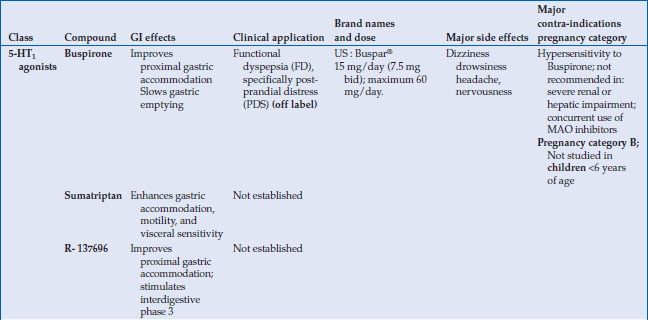
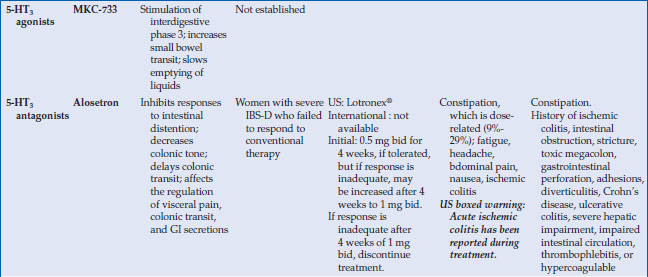
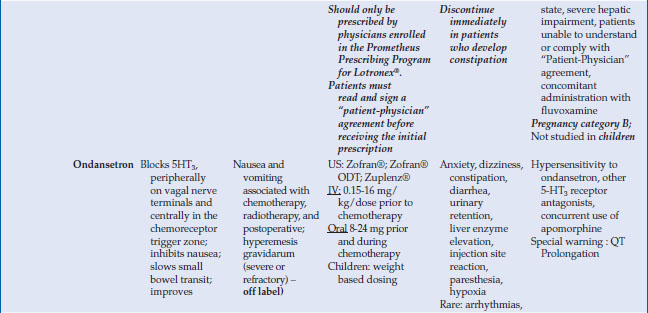

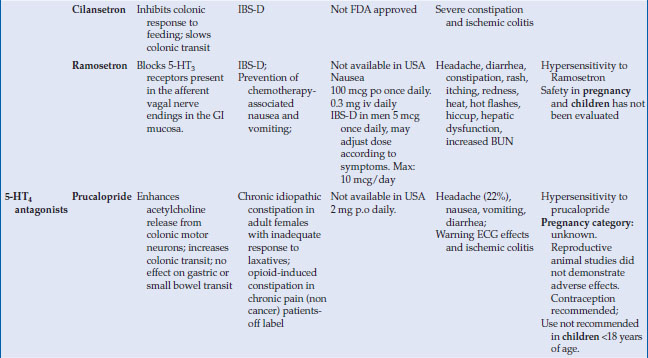
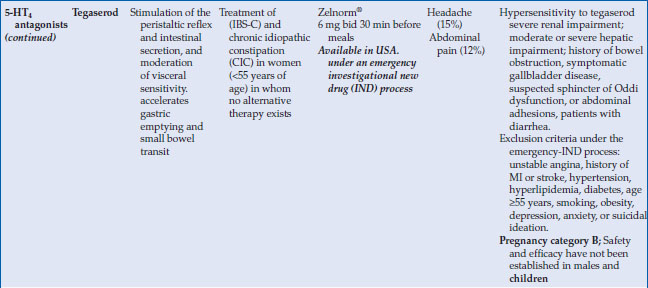
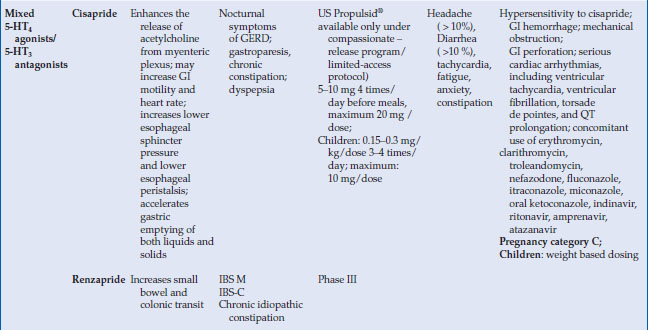
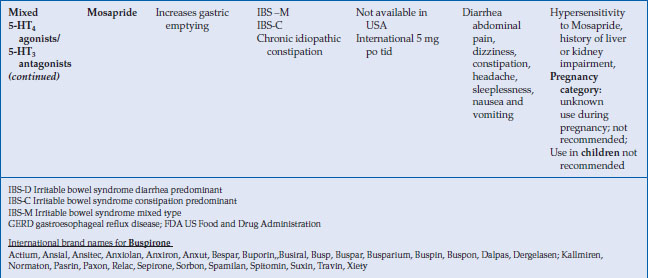
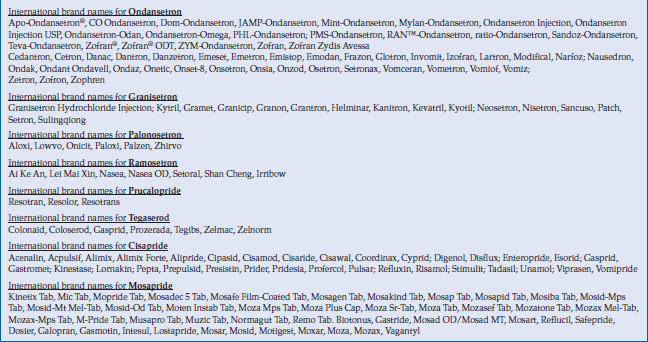
5-HT agents approved in the US for specific GI indications
Alosetron
In the United States, Alosetron has been approved for the treatment of women with severe diarrhea-predominant irritable bowel syndrome who failed to respond to conventional treatment. The efficacy and safety of Alosetron at a dose of 1 mg twice daily for 12 weeks vs. placebo was determined based on a total of 1273 nonconstipated women with IBS. The primary endpoints of the placebo-controlled trials were adequate relief of pain and discomfort, which was assessed weekly. Secondary endpoints were the percentage of days with urgency and daily assessment of stool frequency and consistency. An additional study compared alosetron (1 mg twice daily) to mebeverine, an antispasmodic approved in Europe for the treatment of IBS. Because of the rare, but serious, side effect of ischemic colitis observed in the clinical trials and early post-marketing surveillance of alosetron, the drug was voluntarily withdrawn from the US marketplace in December 2000. In 2002, it was re-released for monitored use. Physicians must enroll in the Prometheus Prescribing Program for Lotronex® (www.lotronexppl.com or 1-888-423-5227) in order to prescribe this medication.
Tegaserod
Tegaserod is a highly selective partial 5-HT4
Stay updated, free articles. Join our Telegram channel

Full access? Get Clinical Tree






